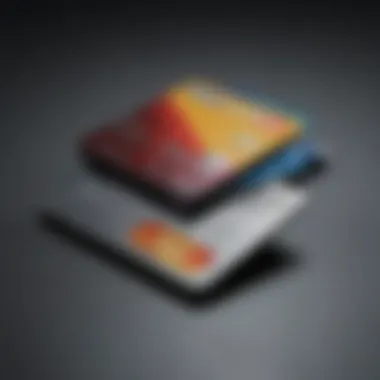Understanding Credit Options in Chapter 13 Bankruptcy


Intro
Navigating the often murky waters of credit options during Chapter 13 bankruptcy can be a daunting task for individuals seeking financial stability. This process isn't merely a phase of debt relief; it's a critical pathway toward rebuilding one’s financial future. During Chapter 13, individuals restructure their debts, pledging to pay back a portion over a fixed timeline, typically three to five years. As part of this journey, understanding the ins and outs of acquiring credit becomes essential. That's where this discussion kicks in.
Understanding how to manage credit during this time not only influences immediate access to financial resources, but it also impacts long-term credit health. The labyrinth of credit cards, lender expectations, and legal nuances can create a fog of uncertainty. With a bit of guidance, however, individuals can shine a light on a path toward empowerment and better financial decisions.
By the end of this article, the goal is to equip you with knowledge that bridges the gap between the legal constraints of bankruptcy and practical steps to reclaiming financial freedom. From evaluating available credit options to providing insider tips, this piece dissects what it means to handle credit wisely amidst bankruptcy. Without further ado, let’s delve into the critical terminology that underpins this discourse.
Understanding Chapter Bankruptcy
Chapter 13 bankruptcy isn't just a legal term stamped on paperwork; it's a lifeline for many struggling financially. For individuals facing overwhelming debt, it offers a structured path to regain control over their finances while retaining their assets. This unique bankruptcy approach allows consumers to create a repayment plan to settle debts over a period, often three to five years. Understanding this process is crucial, as it sets the stage for how one can effectively navigate credit options during and after bankruptcy.
To grasp the nuances of Chapter 13, it’s essential to explore its definition, process, and benefits further.
Definition and Process
Chapter 13 bankruptcy, often referred to as the "wage earner's plan," is aimed at individuals with a regular income who wish to pay their debts. Under this chapter, a debtor proposes a repayment plan to make installments to creditors over three to five years. The goal is to allow individuals to keep their property while settling their debts in a manageable manner.
- Filing for Chapter 13: The process begins with filing a petition in bankruptcy court, detailing one’s income, expenses, and debts.
- Repayment Plan: Within a specific timeframe, the debtor must submit a repayment plan, outlining how they intend to repay their debts.
- Court Approval: This plan must be approved by the bankruptcy court, ensuring that it meets legal criteria and is feasible for the debtor.
- Completing the Plan: Once approved, the debtor makes regular payments to a bankruptcy trustee, who then distributes these payments to creditors.
Overall, this structured approach not only aids individuals in managing their debts but also helps them rebuild credit over time, as timely payments can restore creditworthiness.
Comparison with Chapter Bankruptcy
A common point of confusion lies in the comparison of Chapter 13 and Chapter 7 bankruptcy. While both provide relief from debts, their methods of doing so are notably different.
- Liquidation vs. Reorganization: Chapter 7 involves liquidating non-exempt assets to pay off debts, while Chapter 13 allows individuals to keep their assets by reorganizing their debts into a repayment plan.
- Debtor Eligibility: Chapter 7 has specific income and asset eligibility criteria, whereas Chapter 13 is designed specifically for individuals with regular income, permitting higher earning debtors to qualify.
- Duration: Chapter 7 typically resolves within a few months, while Chapter 13 is a longer, more involved process that spans several years.
This differentiation plays a significant role in determining which path is appropriate based on one’s financial situation and future goals.
Eligibility Requirements
Understanding eligibility requirements is essential for anyone considering filing for Chapter 13. Here’s what potential debtors need to have in mind:
- Regular Income: Individuals must prove they have a reliable source of income to fund the repayment plan.
- Debt Limits: There are also statutory limits on the total amount of secured and unsecured debts. As of April 2022, those limits are $1,257,850 for secured debts and $419,275 for unsecured debts.
- Credit Counseling: Before filing, individuals must complete a credit counseling course to explore possible alternatives to bankruptcy.
In short, understanding these critical elements can be the difference between regaining financial stability and facing prolonged hardship.
"Filing for Chapter 13 can seem daunting, but when navigated correctly, it offers an invaluable framework to rebuild both credit and financial health."
Engaging deeply with this section lays the groundwork for exploring subsequent segments focused on utilizing credit cards and financial tools as part of the recovery process.
The Role of Credit Cards in Financial Recovery
When someone finds themselves in the midst of Chapter 13 bankruptcy, it may feel like they are facing an uphill battle. However, utilizing credit cards responsibly can actually play a significant role in their road to financial recovery. The essence lies not in merely acquiring a credit card, but in how it can be leveraged to rebuild a tarnished credit score and manage finances more effectively.
Rebuilding Credit Scores
One of the prime benefits of acquiring a credit card during this difficult phase is its potential to aid in rebuilding credit scores. After a bankruptcy declaration, many individuals notice a sharp decline in their scores, often feeling like they have hit rock bottom. Yet, the key to climbing back up often rests in the consistent use of a credit card. By making small purchases and paying the balance on time, individuals can demonstrate responsible credit usage, which plays a pivotal role in improving their creditworthiness.
“Timely payments on even the smallest of expenditures can make a world of difference,” many financial advisors would agree. The consistency shows creditors that an individual is committed to improving their standing, and this can slowly mend the post-bankruptcy credit profile.
"Rebuilding a credit score is like tending to a garden; regular care and patience yield the best results."
Financial Tools for Debt Management


Credit cards can also serve as practical tools for managing finances, especially when utilizing the right strategies. Elevated interest rates on some credit cards are often daunting, yet understanding how to employ them can make a marked difference in one’s debt management plan. A secured credit card, for instance, might require a cash deposit, which can help limit the risk of overspending.
Here are some points to consider:
- Soft limit on spending: This encourages disciplined financial habits.
- Credit utilization rates: Keeping this below 30% improves credit scores effectively.
- Rewards and cashback options: Even in tough times, some cards offer incentives that may lower overall expenses.
Furthermore, using financial tools, such as budgeting apps or software, allows individuals to track their spending habits more rigorously. These digital resources not only provide real-time insights into one’s financial standing but also help in forming a habit of savings and responsible spending—crucial skills when trying to work back up in the financial arena.
The dual approach of improving credit scores while managing finances can set a clear path towards financial stability. Balancing the use of credit smartly could make a world of difference in ensuring a successful financial recovery during and after the Chapter 13 process.
Can You Get a Credit Card During Chapter ?
Understanding the dynamics of credit cards during Chapter 13 bankruptcy is crucial for anyone looking to regain financial stability. Chapter 13 allows individuals to reorganize their debts while maintaining certain assets, unlike Chapter 7 which may require liquidation of non-exempt properties. The foray into credit cards while encapsulated under bankruptcy proceedings opens a broad discussion about the tools available for rebuilding credit and managing finances under strict regulations. This section sheds light on what one can expect, highlighting the tangible benefits of credit cards as financial instruments and the considerations that must be taken into account before jumping in.
Understanding the Legal Framework
Diving into credit cards during Chapter 13 bankruptcy requires familiarity with the legal landscape. Legally, individuals under Chapter 13 are allowed to obtain credit, although this doesn't come without constraints. While there's no outright ban on acquiring new credit lines, it is important to remember that any new spending must be disclosed to the bankruptcy trustee. Moreover, creditors often conduct thorough reviews before granting credit, examining your repayment plan or existing debt.
The key takeaway is that while you can apply and potentially receive credit cards, maintaining transparency is non-negotiable. As one might say, it's better to err on the side of caution than to land in hot water. Consider consulting with a bankruptcy attorney who can provide guidance on what is permissible, helping to sidestep potential legal troubles down the line.
Types of Credit Cards Available
Secured Credit Cards
Secured credit cards are often the first stop for individuals seeking to rebuild credit post-bankruptcy. These cards require a cash deposit that serves as collateral, thereby reducing the lender's risk. A pivotal characteristic is that your credit limit often equals your deposit, making it a lower-risk option for both you and the lender.
The unique feature here is that as you use the card and make timely payments, it builds your credit history. This practice can set you on the right path to higher credit scores and possibly to unsecured credit in the future. Yet, it’s wise to be aware of the fees associated with these cards, which can sometimes feel like a hidden trap. Overall, secured cards are a popular choice due to their accessibility and credit reconstruction potential.
Unsecured Credit Cards with Limitations
On the flip side, unsecured credit cards with limitations are also available, although with tighter restrictions. Generally, these cards come with lower credit limits and may have higher interest rates. A notable attribute is that while you don't need to provide a cash deposit, your creditworthiness will be under a microscope.
What sets these cards apart is their capacity for uplifting one’s credit score without the burden of upfront capital. However, it’s essential to remain vigilant: late payments can still wreak havoc on your credit report, and if you exceed your limit, the penalties can add up quickly. Thus, while unsecured cards may provide more freedom compared to secured ones, they also entail risks that should not be overlooked.
Criteria for Approval
Credit card approval during Chapter 13 hinges on several criteria, reflecting how you manage your finances under the repayment plan. Lenders typically assess elements such as:
- Current Bankruptcy Status: Your status in the bankruptcy process is crucial. They often want proof that you’re adhering to the plan and managing current debts responsibly.
- Income Level: A stable income helps sway approval decisions, showcasing your capacity to make timely payments.
- Credit History: Even post-bankruptcy, elements of your credit history play a key role, particularly your repayment habits prior to filing.
- Existing Debt Obligations: Lenders will consider your current debts and how they might affect your ability to handle more credit.
In summary, obtaining a credit card during Chapter 13 is feasible but comes with its share of complexities. By understanding the legal framework, knowing what types of cards are available, and meeting the criteria for approval, you can gradually navigate the path toward financial recovery in a structured way.
Impact on Bankruptcy Repayment Plans
Understanding how credit card usage can impact repayment plans during Chapter 13 bankruptcy is crucial. Essentially, the repayment plan is designed to manage one's debts effectively while maintaining a level of financial stability. It’s a balancing act, and the use of credit during this period can tip the scales in various ways.
The primary aim of Chapter 13 is to allow individuals to reorganize their debts while making manageable payments over three to five years. Integrating new credit card use can affect this balance, as fresh debt may complicate the already intricate landscape of financial obligations.
How Credit Card Usage Affects Plans
When individuals find themselves approved for a credit card during Chapter 13, the initial euphoria of having access to funds can quickly turn into a double-edged sword. On one hand, it might provide essential purchasing power, especially for unexpected expenses. On the other hand, it can lead to additional debt that wasn’t accounted for in the original repayment plan. This can cause several issues:
- Confusion Regarding Debt Obligations: New charges might lead to misunderstandings regarding what should be prioritized in repayments.
- Potential for Increased Payments: If the bankruptcy trustee perceives an increase in liabilities, it might result in modified payment requirements, which could strain the budget further.
- Credit Score Implications: Depending on how credit card usage is managed, it could either help in rebuilding credit or further damage it, leading to a more tumultuous financial future.
One critical takeaway is to use credit judiciously. It’s evident that reckless spending can derail the progress made under Chapter 13.
Communication with Your Trustee


Communication with the bankruptcy trustee becomes vital when incorporating credit card usage into the repayment plan. The trustee essentially acts as a mediator, ensuring that the repayment plan adheres to legal standards while being fair to creditors. Therefore, it’s important to keep them in the loop about any new debts incurred.
Being transparent with the trustee helps avoid misunderstandings that could result in drastic consequences. Some points to consider include:
- Reporting New Credits: It’s essential to report any new credit lines to the trustee, who can then reassess how these may impact the repayment plan.
- Seeking Guidance: Trustees can offer advice on how to incorporate these changes while avoiding detrimental effects on your plan.
- Documenting Usage: Keeping thorough records of credit card use during Chapter 13 can strengthen your case when discussing with your trustee.
Ultimately, open dialogue with the trustee aids in navigating the complexities of revised financial obligations during bankruptcy, ensuring that you’re not walking a tightrope blindfolded.
Maintaining Financial Discipline
Maintaining financial discipline is a cornerstone of successfully managing one’s finances during and after Chapter 13 bankruptcy. This phase can be quite tumultuous, and without a firm grip on spending habits and budgeting, it’s easy to tumble back into the same pit of financial woes. The emphasis here is on creating a sustainable plan that not only aids in meeting the repayment terms of the bankruptcy but also facilitates better decision-making long after the bankruptcy concludes.
Establishing a Budget
Establishing a budget isn’t just about pinching pennies; it’s about outlining a clear financial roadmap that guides day-to-day spending and prioritizes your financial obligations. This requires a thorough assessment of your income against your necessary expenses.
To get started:
- List Your Income: Be clear and honest about how much you earn each month.
- Identify Necessary Expenses: Categorize your spending into needs versus wants. Essentials like housing, food, and transportation take precedence.
- Set Spending Limits: Allocate a specific amount to each expense category, which helps prevent overspending.
- Track Your Spending: Use a spreadsheet or an app to monitor your expenses against the budget. This keeps you accountable and informs any necessary adjustments for the next month.
The act of budgeting encourages discipline. It forces you to be aware of where your money goes, helping to curb impulsive purchases that can dramatically derailed your financial recovery.
Avoiding Credit Overreach
While the urge to use credit may be strong, especially in a post-bankruptcy context, overreach can lead to more debt and financial instability. It’s vital to understand the boundaries of responsible credit use.
A few strategies to prevent overreaching include:
- Understand Your Limits: After bankruptcy, many people are granted limited credit lines. Know how much you can borrow without falling into the trap of excessive debt.
- Prioritize Needs Over Wants: Always ask yourself if the purchase is necessary when considering using credit. Avoiding needless spending protects your financial health.
- Regularly Review Financial Goals: Keep checking back on your long-term goals as a reminder of why you are maintaining discipline in the first place.
Remember, it's not just about avoiding pitfalls today; it's about establishing a solid foundation for the future.
Discipline isn’t merely a means to an end; it’s the compass that will guide you through the turbulent waters of bankruptcy and into a stable financial future. As you navigate these waters, having a robust grasp of your budget and an acute awareness of your credit usage will greatly bolster your chances of fiscal rejuvenation.
Long-Term Credit Management Post-Bankruptcy
Long-term credit management after filing for Chapter 13 bankruptcy is of great significance. When individuals navigate through the difficulties of bankruptcy, the path to reestablishing financial credibility lies in an astute management of credit in the future. Many people mistakenly believe that simply emerging from bankruptcy is the finish line. On the contrary, this marks the beginning of a new chapter where credit practices must be reevaluated and managed with careful precision. The focus shifts from a reactive stance, coping with immediate financial constraints, to a proactive approach that seeks sustainable financial health.
Understanding how to manage credit over the long haul post-bankruptcy is essential for several reasons. First, it sets the foundation for improved credit scores, which can lead to lower interest rates on loans or credit cards, as well as better chances of credit approval in the future. Moreover, rehabilitating one’s credit profile allows individuals to regain trust with lenders, which is paramount in times requiring significant borrowing, like purchasing a home or financing a vehicle.
Assessing Credit Reports Regularly
Engagement with one's credit report is a crucial element after bankruptcy. Regularly assessing credit reports means that individuals can track changes, identify errors, and keep tabs on creditor activities. Every credit reporting agency—Experian, TransUnion, and Equifax—allows you to obtain one free report every year. By taking advantage of these opportunities, individuals can stay informed about their credit status.
Regular assessments help in several ways:
- Identifying errors: Mistakes can adversely affect credit scores. If there are inaccuracies, they can hinder the recovery process.
- Monitoring recovery progress: Watching how scores improve over time can provide motivation to maintain financial discipline.
- Understanding credit utilization: Knowing current limits and balances can aid in avoiding overreach and maintaining an optimal debt-to-credit ratio.
"Knowledge is power, especially when it comes to taking hold of your financial future."
Strategies for Future Credit Building
Developing strategies for credit building post-bankruptcy is indispensable. Moving forward, it’s not merely about having access to credit, but rather about using it wisely. Here are some effective approaches:
- Start Small: Opt for a secured credit card initially. This means depositing money that acts as your credit limit, reducing risk for the lender while enabling you to rebuild your credit history.
- Payment Timeliness: Make it a habit to pay bills on time. Late payments will significantly hamper any credit rebuilding efforts.
- Diversify Credit Types: As time passes, explore options for different types of credit (an installment loan or retail credit) to enhance your credit mix, which can positively influence your score.
- Limit New Applications: Be cautious not to apply for too many new credit accounts at once. Each application results in a hard inquiry that can drop your score.
- Engage with Credit Counseling: Seeking the help of a financial advisor or credit counselor can help navigate the path to credit recovery with tailored strategies catered to the individual’s financial position.


By embracing a long-term strategy for credit management, one can effectively reshape financial outcomes, ensuring that the mistakes of the past do not dictate future possibilities.
Common Mistakes to Avoid
Navigating the waters of Chapter 13 bankruptcy can feel a bit like walking on a tightrope. While many individuals focus on reestablishing their financial footing, certain missteps can throw a wrench in the whole process. Recognizing these common blunders is crucial. Understanding what can go sideways could save you heaps of trouble down the line. Here, we’ll delve into two significant mistakes: misunderstanding credit terms and neglecting legal obligations.
Misunderstanding Credit Terms
First off, a considerable pitfall lies in a misunderstanding of credit terms. It’s akin to jumping into a swimming pool without knowing how deep it is; you might find yourself in over your head. In the realm of credit cards, terms like APR, credit limit, and fees can be a bit convoluted. Don’t be easily dazzled by promotional offers. For instance, a low introductory APR might sound enchanting. Yet, once the promo period expires, it could balloon into something you didn't see coming.
- Annual Percentage Rate (APR): This is essentially the yearly cost of borrowing. If it’s high after an introductory offer, your balance can grow thin fast, despite small monthly payments.
- Credit Limit: A higher limit might seem like a safety net, but it can often lead to overspending, especially when you are in a vulnerable financial position.
- Hidden Fees: Always read the fine print. Fees for late payments, cash advances, or foreign transactions can sneak up on you.
Assessing all these details meticulously can prevent hasty decisions. Even with the allure of a shiny new credit card, ensure you grasp the terms and conditions fully before signing the dotted line. Taking the time to be well-informed can pay dividends in the long run.
Neglecting Legal Obligations
The other major misstep is neglecting your legal obligations. When you are in Chapter 13 bankruptcy, you’ve got a plan in place — the repayment plan, to be exact. Ignoring this responsibility can come back to bite you quicker than a snake in the grass. Staying compliant with the court-mandated repayment plan is paramount. Failing to do so may not only lead to dismissal of your case but also trigger immediate collection actions by creditors that you had hoped to leave behind.
- Consistent Payments: Making consistent and full payments as per your plan will not just help in keeping your case alive but also boost your credit reputation post-bankruptcy.
- Notify Your Trustee: Should any financial hiccup arise, communicate with your trustee promptly. They’re in your corner and can offer guidance or options if you’re facing challenges.
- Bankruptcy Follow-Up: After discharge, ensure that you fully understand how your bankruptcy affects your credit report and what you must do thereafter.
Neglecting these obligations can not only jeopardize your current chapter 13 status but could also haunt your financial future. By adhering to your responsibilities and acknowledging the weight of legal structures in place, you set yourself up for a smoother recovery.
"The road to financial freedom is paved with knowledge and responsibility."
The takeaway here is clear: comprehending credit terms and adhering to your legal obligations while in Chapter 13 bankruptcy is crucial for a successful financial rebound. Don't let a couple of missteps sink your ship when you're so close to reclaiming your credit health.
Consultation with Financial Advisors
Consulting a financial advisor during Chapter 13 bankruptcy can be a game changer. This phase of financial restructuring can be like walking a tightrope; a misstep can mean falling back into financial chaos. Advisors bring a wealth of knowledge, knowing the ins and outs of financial survival after a bankruptcy. Understanding the benefits of professional guidance here is not just prudent, it’s essential.
Importance of Professional Guidance
Professional guidance from a financial advisor goes beyond mere advice. It offers a strategic edge when navigating the complex waters of bankruptcy. Advisors help you manage your expectations regarding credit improvement. They can clarify how your actions today impact your credit score tomorrow, a critical factor in your recovery plan.
Moreover, they help clarify the tangled web of legal obligations you’re under while in Chapter 13. Take, for instance, the discussions about acquiring credit cards; an advisor can explain how certain purchases can jeopardize your repayment plan. Knowledge is power, and having a professional on your side means making informed choices rather than guessing in the dark.
"Working with a financial advisor can illuminate the way forward, bringing clarity amidst uncertainty."
Choosing the Right Advisor
Finding the right advisor is no cafeteria pick and choose. It requires diligence. Look for professionals who specialize in bankruptcy or debt management. They should exhibit understanding, not just of your situation but also your personal values and financial goals. An advisor who fits well can help you craft a personalized approach to rebuilding your credit while juggling your repayment plan.
Questions such as:
- What is your experience with clients in Chapter 13?
- How do you ensure my financial objectives are met?
- What’s your fee structure, and does it match my budget?
Studying an advisor's background, reviews, and methodologies can save you time and possibly money.
In summary, a financial advisor can provide a lifeline during this turbulent time. Choosing wisely can not only set your course for recovery but also empower you to reclaim control over your financial future.
Ending
Summation of Key Points
- Legal Framework: Chapter 13 bankruptcy provides a flexible repayment plan, allowing individuals to manage their debts while maintaining certain assets. However, the legal restrictions surrounding credit usage during this period are complex and must be navigated carefully.
- Types of Credit Cards: The availability of secured versus unsecured credit cards presents individuals with options, each having unique implications on credit scores and overall debt management. Secured cards often come with lower barriers to entry, making them a safer starting point.
- Financial Discipline: Establishing good financial habits by creating a budget and adhering to a realistic debt repayment plan is vital. The importance of communicating with trustees and creditors cannot be overstated, as transparency often leads to better outcomes.
Final Thoughts on Credit Usage During Bankruptcy
The key takeaway regarding credit usage during Chapter 13 bankruptcy revolves around a delicate balance. It's about employing credit strategically rather than recklessly. Using credit wisely can potentially aid in enhancing credit scores over time, but misuse can lead to complications.
One shouldn’t forget that while seeking to re-establish credit, it is essential to remember the lessons learned from financial hardship. The act of rebuilding is not merely logistical but emotional as well. Maintaining awareness of spending habits, understanding the fine print in credit agreements, and seeking advice from experienced financial professionals strengthens one’s ability to emerge from this challenging phase equipped for future success.
"In the aftermath of bankruptcy, credit can be both a tool and a trap; knowing which path to take can mark the difference between failure and financial empowerment."
Arming oneself with knowledge about available options and making informed decisions remains critical. As individuals wade through the complexities of Chapter 13 bankruptcy, approaching credit usage with caution and strategic thinking can contribute significantly to long-term financial health.







